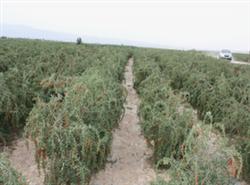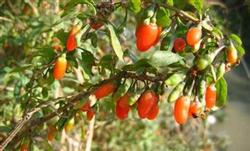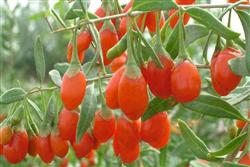Control of black fruit disease of Lycium barbarum

Black fruit disease is one of the main diseases of Chinese wolfberry. The pathogen harms the green fruits, flowers and buds of Chinese wolfberry, as well as twigs and leaves. After the disease of Chinese wolfberry green fruit, small black spots or black spots or black reticular lines begin to appear. On cloudy and rainy days, the disease spot expands rapidly, which blackens the fruit and grows orange conidia, which cannot be used as medicine. In sunny days, the disease spot develops slowly, the disease spot turns black, and the unaffected part can still turn red. After the flower is infected, the petals first appear black spots, the light ones can still bear fruit after the Corolla falls off, the heavy ones become black flowers, the ovary is withered and can not bear fruit. After the flower bud is infected, there are small black spots or black spots in the initial stage, and when it is serious, it is a black bud, which cannot be opened. Small black spots or black spots appear after the branches and leaves are infected. The pathogen overwinters in the diseased fruit, and the Chinese wolfberry can also survive the winter on the surface of the black fruit. Mainly through the wind and Rain Water spread to the nearby healthy flowers, fruits, buds and other parts, infect the host, carry on the harm, the temperature played a role in promoting the disease. Lycium barbarum can be infected by the disease from the early fruit stage in early May to the last fruit stage in mid-October. In the initial stage (May-June), the daily average temperature is more than 17 ℃ and the relative humidity is about 60%. There is 2-3 days of rain every ten days, and the disease can occur in the field. During the peak period (July-September), the daily average temperature was about 17.8-28.5 ℃, the ten-day rainfall was more than 4 days, and the average humidity for two consecutive days was more than 80%, and the incidence increased sharply. In the later stage (from October to the first frost period), the ten-day average temperature is 9.2-14.6 ℃. As long as there is more than one rainy day in the field, the disease will still occur seriously. The method of prevention and control is to clean up the wolfberry orchard in winter, remove and burn the infected fruits, leaves, branches, etc., spray 50% bacillus special wettable powder 600 times dilution, spray the same amount of Bordeaux solution 100 times dilution.
- Prev

How to prevent and cure black fruit disease of Chinese wolfberry
Black fruit disease of Chinese wolfberry harms the green fruits, flowers and buds of Chinese wolfberry, as well as twigs and leaves. Lycium barbarum can be infected by the disease from the early fruit stage in early May to the last fruit stage in mid-October. From May to June, the daily average temperature is more than 17 ℃, the relative humidity is about 60%, and there is 2-3 days of rainfall every ten days, which can cause disease in the field. From July to September, the daily average gas.
- Next

High yield and high quality cultivation of Lycium barbarum
Lycium barbarum is a deciduous shrub of the genus Lycium barbarum of Solanaceae. Its leaves, fruit roots and bark all have extensive medicinal value. Strong resistance, fertilizer and water resistance, not only suitable for drought, sand wasteland, saline-alkali land planting, but also an excellent tree species in courtyard economy; the fruiting period is long, it can be planted to 50 years in the same year, and it can enter the full fruit period in 3-4 years.
Related
- Fuxing push coffee new agricultural production and marketing class: lack of small-scale processing plants
- Jujube rice field leisure farm deep ploughing Yilan for five years to create a space for organic food and play
- Nongyu Farm-A trial of organic papaya for brave women with advanced technology
- Four points for attention in the prevention and control of diseases and insect pests of edible fungi
- How to add nutrient solution to Edible Fungi
- Is there any good way to control edible fungus mites?
- Open Inoculation Technology of Edible Fungi
- Is there any clever way to use fertilizer for edible fungus in winter?
- What agents are used to kill the pathogens of edible fungi in the mushroom shed?
- Rapid drying of Edible Fungi

